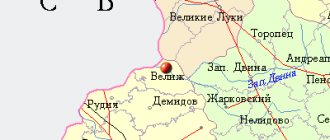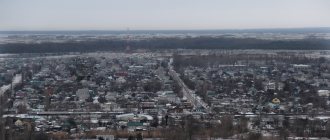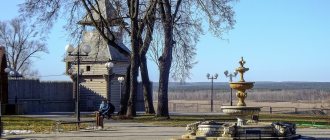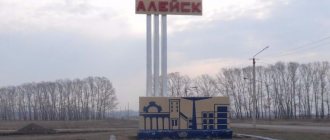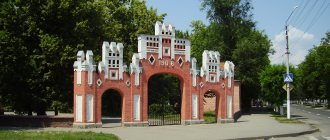Year founded: 1933
Malgobek celebrates the city day on
the 1st Sunday of September
.
In 2022,
this date is
September 4
.
Malgobek - City of Military Glory (Photo: malgobek.ru)
Malgobek
– Russian city in Ingushetia, administrative regional center. Located in the Ciscaucasia, on the southern slope of the Tersky Range in the Alkhanchurt Valley.
The city was founded in 1933
. In those years, new oil fields were actively being developed on the site of former Chechen villages. It was with the discovery by oil workers of well No. 13 on the Tersky Range that the history of Malgobek began, whose name is associated with the Magial-Bek tract, according to the title of the owner of these lands at that time.
The city was rightfully considered an achievement of the first five-year plans of the Soviet era. Experts from different fields came from all over the union: first of all, oil workers, engineers, and builders. Active development of Malgobek began. A railroad was built, various social institutions were built, houses, shops, and new oil derricks were built. Residents of the city are still proud of this powerful all-Union achievement: in the 30s, it was here that a drilling rig 5 kilometers deep was installed and launched. Already in 1941, Malgobek oil workers produced more than 1 million 300 thousand tons of oil, rightfully receiving the title of “The best drilling company in the Soviet Union.” But the Great Patriotic War began.
During the war years, many residents went to the front, and those who remained continued to extract oil, supplying the country with fuel for aircraft. In 1942 the city was besieged. For Germany, the capture of the Caucasus with its oil deposits was of the utmost strategic importance. Hitler’s plans included the capture of three most important points: Malgobek, Grozny, Baku. In this regard, the significance of the Malgobek defensive operation becomes clear. Soviet troops stopped the enemy, preventing him from approaching Grozny and Baku and thus transferring military forces to Stalingrad, although they paid a high price for this. About 120 thousand soldiers defending the city died in battle. And on January 3, 1943, the city of Malgobek was liberated from fascist troops.
The IS-3 tank is a monument to the soldiers of the 52nd Tank Brigade, the defenders of the city of Malgobek (Photo: wikipedia.org) For the courage, fortitude and heroism shown by the soldiers at the walls of the city, by Decree of the President of the Russian Federation
in 2007, Malgobek was awarded the honorary title “Military City glory
.
At the entrance to the city you can see a monument to the soldiers of the 52nd Separate Guards Tank Brigade. In total, about 30 monuments, steles and obelisks at mass graves remind of the heroic past of Malgobek; there are also 120 military graves on the territory of the city.
In Sergo Ordzhonikidzhe Park there is a memorial complex “Glory” and a museum of military and labor glory of Malgobek. There is a monument with the graves of 800 Soviet soldiers, a stele and a plaque of honor; in honor of the fallen soldiers, the Eternal Flame is always burning in the park. In the museum you can get acquainted with the labor history of the city associated with the development of oil wells. At one time, famous oil workers worked here - Heroes of Socialist Labor Marina Yakovlevna Pauk, Fyodor Lvovich Kolesnikov, Alexander Ivanovich Levshin, Akhmed Biberdovich Lologaev and others.
The city is home to more than 39 thousand inhabitants (2020), the bulk of the population are Ingush.
Day of the city
celebrated on the first Sunday of September.
Coat of arms
The coat of arms of the urban district of Malgobek is a circle, in the center of which, along the vertical axis against the background of the Caucasus mountains, is a stele erected in honor of conferring the title of city of military glory on the city of Malgobek. On the left side of the stele is Table Mountain (“Matloam”), on the right is Mount Kazbek (“Bashloam”) Above the mountains and the stele there is an image of the rising sun, from which seven straight rays diverge upward, symbolizing the revival of the city. The image of the inner circle below is framed by ears of wheat symbolizing fertility. Between the large and small circles there is an inscription: at the top – “MALGOBEK”, at the bottom – “CITY OF MILITARY GLORY”. The inscriptions are separated by asterisks. The white color on the coat of arms symbolizes the purity of thoughts and actions characteristic of the residents of the city of Malgobek. Blue is the color of the sky, space; green - represents nature, abundance and fertile lands, as well as a symbol of Islam. The color red is a symbol of the blood shed on the battlefields on the outskirts of Malgobek. Yellow is the color of the Sun, which gives life to man and nature, the color of rebirth. Brown is the color of the scorched earth of battlefields.
Geographical position
43 km north-west of the capital of Ingusheti and Magas is the city of Malgobek (43°31? N, 44°35? E) - the administrative center of the Malgobek region . Malgobek is the second largest city in Ingushetia: its area is 11 square meters. km, population – 34,385 people (as of January 1, 2014). The national composition of the city's population: Ingush -89.7%, Chechens -6.6%, Russians -1.6%, Turks -1%.
Climate
The city is located in a continental climate zone. Winter here is short and mild (average January temperature is -4? C), with frequent thaws, fog, and precipitation in the form of sleet. Summer is warm (+20°C in July), with heavy rains that increase water levels in rivers and cause mudflows in the mountains. The average annual precipitation is about 750-800 mm.
Natural attractions
Malgobek is located in a hilly area on the southern slope of the Tersky Range in the Alkhanchurt Valley. Due to the lack of fresh water, the city has little greenery. On its territory there is a city park with figures of popular cartoon characters installed on the alleys.
The subsoil of the city is rich in oil and gas; since 1935, a large oil field has been developed here - Malgobek -Gorskoye. the Malgobek oil pipeline originates here .
Story
Malgobek is a young city, founded in 1939 after the start of development of Malgobek -Gorsk oil and gas field in 1935. The city arose on the site of the old Chechen villages Malgobek-Balka and Chechen-Balka, located in the Magial-Bek tract, from which the name of the city apparently came.
During the Great Patriotic War, Malgobek was an important strategic object on the way of the advance of Hitler's troops to the oil regions of the Caucasus. Defensive battles under besieged Malgobek continued for four months, and at the beginning of 1943 the Germans were driven far to the north. The victory in the Malgobek operation stopped the advance of fascist troops in the south of the USSR. For his outstanding contribution to the fight against the Nazis, Malgobek was awarded the title of city of military glory in 2007. The city has 15 monuments related to the Great Patriotic War, the largest of which are:
— a memorial complex of Military Glory in the central square with a monument located on its territory with the names of fallen soldiers, an eternal flame and a stele in honor of the city being awarded a high rank,
- memorial to the “Defenders of Malgobek” in the city park named after. Sergo Ordzhonikidze ,
- Museum of Military and Labor Glory (branch of the Ingush State Museum of Local History named after Malsagov).
Many of the city's streets are named after the defenders of Malgobek .
Famous people
Malgobek is the small homeland of the people's writer of Ingushetia A.Kh. Bokov. , artist Polonkoev M.M. , Honored Doctor of the Russian Federation R.N. Salatov
How to get there
get to Malgobek by train "Moscow-Grozny" of the North Caucasus Railway (the Mozdok railway station is located 43 km from Malgobek ), by car along the P292 "Argudan - Aleksandrovskaya". Nearest airports: Beslan (38 km), Magas (43 km).
Administrative and municipal status
As part of the structure of administrative units, Malgobek serves as the administrative center of Malgobek District, even though it is not part of it.[ citation needed
] As an administrative division, it is registered separately as
the city of republican significance of Malgobek
- an administrative unit with a status equal to that of districts. [
citation needed
] As a municipal entity, the city of republican significance of Malgobek is included as the
Malgobek urban district
.[4]
Climate
Malgobek has a humid continental climate (Köppen climate classification: DFA
).
| Climate data for Malgobek | |||||||||||||
| Month | Jan | Feb | Mar | Apr | May | Jun | Jul | Aug | Sep | October | But I | December | Year |
| Average high °C (°F) | 0.5 (32.9) | 2.0 (35.6) | 7.4 (45.3) | 15.9 (60.6) | 22.0 (71.6) | 25.8 (78.4) | 28.1 (82.6) | 27.7 (81.9) | 22.4 (72.3) | 15.6 (60.1) | 8.1 (46.6) | 3.0 (37.4) | 14.9 (58.8) |
| Daily average °C (°F) | −3.3 (26.1) | −2.2 (28.0) | 2.8 (37.0) | 9.8 (49.6) | 15.8 (60.4) | 19.6 (67.3) | 22.1 (71.8) | 21.6 (70.9) | 16.4 (61.5) | 10.2 (50.4) | 4.0 (39.2) | −0.7 (30.7) | 9.7 (49.4) |
| Average low °C (°F) | −7.1 (19.2) | −6.4 (20.5) | −1.7 (28.9) | 3.8 (38.8) | 9.7 (49.5) | 13.5 (56.3) | 16.2 (61.2) | 15.5 (59.9) | 10.5 (50.9) | 4.9 (40.8) | 0.0 (32.0) | −4.3 (24.3) | 4.6 (40.2) |
| Average precipitation mm (inches) | 26 (1.0) | 27 (1.1) | 35 (1.4) | 55 (2.2) | 85 (3.3) | 106 (4.2) | 83 (3.3) | 69 (2.7) | 50 (2.0) | 40 (1.6) | 36 (1.4) | 31 (1.2) | 643 (25.4) |
| Source: [10] | |||||||||||||
Malgobek
Foundation of the city
The appearance of the new city of Malgobek on the map is associated with the discovery of an oil field in these places in 1933. The discoverer was oilman Kabir Taizetdinov. The first industrial influx of “black gold” was received on August 24, 1933. This day is considered to be the founding day of Malgobek. Oil of the highest quality flowed from the wells of the new settlement throughout the country, becoming the basis for the economic development of Malgobek.
After some time, Malgobek turns into a shock construction site of allied significance. This ensured an influx of new population into the future city. Malgobek is called one of the main achievements of the second five-year plan. The quality of Malgobek oil was so high that almost all of it was used for the production of aircraft fuel. Along with the development of oil wells, the settlement also developed.
In 1934, Malgobek received the status of a workers' village. And on August 27, 1939, the workers’ settlement officially became a city.
Malgobek during the Great Patriotic War
The Great Patriotic War prevented further development of Malgobek. Despite the fact that hostilities had already begun in the country, oil workers continued to work. In 1941, the largest amount of oil was produced in the entire pre-war period. The fascist occupiers came to the city in 1942. The Nazis knew that small Malgobek was one of the most important oil arteries of the entire Soviet Union, and they tried with all their might to occupy the city. At the beginning of September 1942, the city was occupied. After Malgobek was captured, 5 thousand specialists arrived here, whose tasks were to manage oil production and the work of industrial enterprises.
In the second half of September 1942, Soviet troops approached Malgobek. The battle for the city lasted at least a month. The enemy forces significantly exceeded the forces of the Soviet troops. The city changed hands several times. The Soviet troops were given a goal: to prevent the enemy from taking advantage of the oil wells. The only way to carry out this plan was destruction. The Malgobek defensive operation ended in early October 1942. The city was completely destroyed, but the goal was achieved - the oil did not go to the Nazis. The result of the Malgobek operation had a significant impact on the outcome of the fighting on the entire Transcaucasian front. Thanks to this operation, Soviet troops thwarted many plans of the fascist occupiers, in particular plans to seize the Baku and Grozny oil regions. The Nazis knew about the high quality of Malgobek oil and decided to capture this city first. The final liberation of Malgobek took place on January 3, 1943. Work to restore the city began immediately. Less than a month had passed before oil was again being extracted from old wells.
The defensive operation in Malgobek had not only strategic but also political significance. Thanks to the tenacity and courage of the Soviet soldiers, as well as the fearlessness of the local population, who actively assisted the Soviet soldiers, the enemy was unable to advance into other, no less strategically important areas. In the Great Soviet Encyclopedia of 1954 you can find historical information about the significance of the Malgobek defensive operation. The authors of the encyclopedia confirm the opinion that the operation was able to significantly weaken the enemy’s power, destroying his plans. In addition, the article contains information that if the Soviet troops had been defeated in the fight for the liberation of Malgobek, the Nazis would have been able to transfer forces to Stalingrad. This means that the battle of Stalingrad would have been even more destructive and bloody.
In his book “The Battle for the Caucasus,” Marshal of the Soviet Union A. Grechko also notes the events that occurred in Malgobek in 1942-1943. The marshal writes that the operation in Malgobek even influenced the fighting near Novorossiysk. The author further explains that the enemy was forced to send one of his best divisions, the SS Viking division, to the Mozdok direction at the most tense moment. Thus, the 17th Army operating near Novorossiysk was weakened. Because of this, the enemy’s forces were significantly undermined, and the fighting near Novorossiysk was not successful for the fascist occupiers. The fascists themselves speak not without respect of the feat of Soviet soldiers. German military historian Paul Carell in his book “Eastern Front” summed up the results of the Malgobek defensive operation. Carell reports that the capture of Malgobek was the last chance to reach the oil fields of Baku. However, this chance was missed. The Terek River becomes the border of Hitler's conquests.
Modern period
Currently, the leadership of the Republic of Ingushetia is engaged in the improvement and development of the urban economy. The living conditions of Malgobek residents are also constantly in the spotlight of the authorities. National wealth - oil - is protected by the state. Local authorities constantly oppose privatization. City residents believe that oil wells should not go into private hands. Oil production was suspended for some time. Currently, the first steps have been taken to revive the oil complex. A new oil refinery has opened in the city, producing diesel fuel and gasoline. Oil workers purchased all the necessary equipment for reactivating wells near Malgobek.
Malgobek is considered a young city. Some of its original builders are still alive. However, in these less than 100 years, the city managed to find its place in the history of Ingushetia. The residents of this international city have become an example of how representatives of different cultures and nationalities can coexist on the same land. In 2007, Malgobek was awarded the title of “City of Military Glory”. The conferment of the title was an event of exceptional importance. This is a tribute to the memory of those soldiers and ordinary residents of Malgobek who fully fulfilled their duty to their Motherland. The courage and heroism shown by these people during the defensive operation in Malgobek were able to save the lives of thousands of our compatriots and at least partially reduce the destruction.
